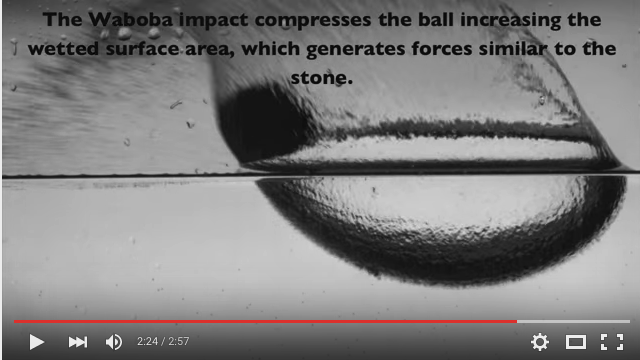Waboba, short for WAter BOuncing BAll, is a new ball designed in 2005 which is be able to bounce on water and promises to Keep Life Fun, like its slogan says. This internationally patented ball has even evolved from only being a fun toy to a full out sport. It has since come out with many additional land and water accessories and toys, but is still known for the original Waboba.
Some of you might say: All balls can bounce on water, so what’s the big deal. Well, that’s only partially true. All balls CAN bounce on water but only in the right conditions, which is when it’s thrown at a shallow angle with enough speed to let it bounce off the surface. This is true even for large solid steel balls. This principle was put into practice during WW2 when the inventor of the “bouncing bomb”, Barnes Wallace, used it in a raid in the Ruhr District dams. He deciphered the physics behind making marbles and any sphere bounce on water. Many people attempted to create and commercialize some kind of sphere that could bounce on water similar to the skipping rock scenario. Jan Von Heland was the first to attempt to perfect the combination of material and composition to make a ball that could bounce easily on the water and in 2004 patented the Waboba. There were other similar balls such as skidderball, but lack of background check and investigation has maybe led to a little confusion with regards to its competition and the ball’s history, so this made for misleading publicity.

Image courtesy of Waboba Channel at Youtube.com
You must throw the ball on the water like you would a pebble on a lake, so you can have fun with this high bouncing ball. It doesn’t bounce on land since it is especially designed for being used on the water. Afterwards, there have been continuous modifications and now there are in total 6 styles: pro, extreme, surf, blast, big kahuna, and fetch. The Pro Waboba is special for athletic uses where control and accuracy are the key be it in a lake or ocean. The Extreme one is perfect for a lake ocean due to its far, fast and high bounces. The Surf version is specially designed for beginners and it’s very easy to play with it be it in the ocean or a lake. The Big Kahuna is the biggest Waboba ball and is also the most multipurpose ball being able to be used in lakes, oceans and pools. The Blast ball is perfect to play in a pool and will guarantee tons of fun. Finally, the Fetch version is great for dogs. All of these versions are designed to give you great fun with a ball that bounces on water!
The Waboba Ball sold for two years in Sweden before branching out to Europe, United States and Australia in 2007. The following year it expanded once again to other markets like Canada, South Africa, and the United Kingdom and the following Brazil, China Singapur, among other countries in Asia and Europe. The expansion continues until in 2013 Waboba has presence in absolutely all European countries and continents with the exception of Antartica.
Once the ball opened the doors to playing sports and other leisure activities with it, other water accessories came out for use in the water like: Catch, which is a glove paired with Waboba Pro, and Waboba Lacrosse used with the Waboba Extreme ball to play water lacrosse. There were also some for land such as Moon (a super high bouncing land ball), Street (unpredictable bouncing ball) and Flyer (an oversized shuttlecock so you can hit with hands, feet, racket or knees)
How to play the game?
This game is usually described as mix between ultimate Frisbee and water polo. This is a team sport played with teams of 4 in the water with a Waboba Pro ball. The official Match game consists of 3 players on each team passing each other the ball, with only one bounce, until they are able to bounce the ball into the goal and score by getting it past the fourth player, the goalkeeper.
The rules for this sport are quite simple. First of all, the game begins once the goalkeeper has passed the ball along to a member of his team. When making passes these should bounce at least one and must be made in the first five seconds of receiving the ball. If you don’t the aforementioned or it bounces out of the pool the referee will let the opposing goalkeeper start again with a new ball. When defending tackling or holding an opponent is not allowed. For the point to count, the ball must bounce before entering the goal. Finally if the referee considers that any of the rules have not been complied with he can give a penalty for delaying the game and the ball is automatically given to the other team.

